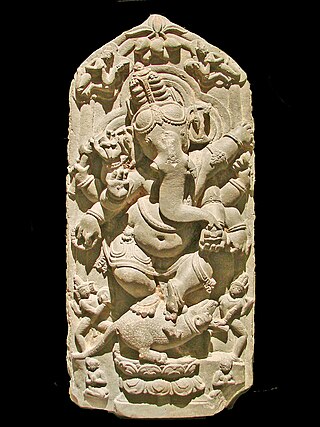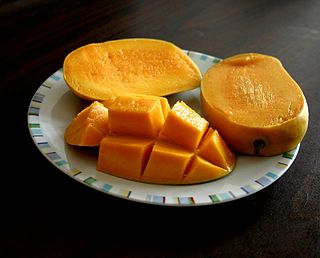
Gombhira, Gambhira or Gamvira is a type of Bengali song and dance originating in the Bengal region, from what is known today as northwestern Bangladesh and north eastern West Bengal, India.

Dinajpur district is a district in the Rangpur Division of northern Bangladesh. Dinajpur is the largest district among all sixteen northern districts of Bangladesh.

Chapainawabganj is located in the north-western part of Bangladesh. It is a part of the Rajshahi Division, and was formerly a sub-division of Malda district of Bengal Province. The north and west part of Chapai Nawabganj is bounded by Malda and Murshidabad districts of India, the east by Naogaon District, and south-east by Rajshahi District.

Malda district, also spelt Maldah or Maldaha, is a district in West Bengal, India. It lies 347 km north of Kolkata, the capital of West Bengal. Mango, jute and silk are the most notable products of this district. The special variety of mango, Fazli, produced in this region is popularly known by the name of the district and is exported across the world and is internationally acclaimed. The folk culture of gombhira is a feature of the district, being a unique way of representation of joy and sorrow in daily life of the common people, as well as the unique medium of presentation on national and international matters. According to the National Investigation Agency Malda is believed to be a hub of a fake currency racket. It is reported that 90 per cent of the fake currency that enters India originates in Malda.

North Bengal or Uttar Banga is a term used for the north-western part of Bangladesh and northern part of West Bengal. The Bangladesh part denotes the Rajshahi Division and Rangpur Division. Generally, it is the area lying west of Jamuna River and north of Padma River and includes the Barind Tract. The West Bengal part denotes Jalpaiguri Division and the Malda division together. The Bihar parts include the Kishanganj district. It also includes parts of Darjeeling Hills. Traditionally, the Ganga River divides Bengal into South Bengal and North Bengal, divided again into Terai and Dooars regions. Jalpesh and jatileswar are some of the most popular sacred places.

Bholahat is an upazila of Chapainawabganj District in the Division of Rajshahi, Bangladesh.

Nakshi kantha, a type of embroidered quilt, is a centuries-old Bengali art tradition of the Bengal region, notable in Bangladesh and Indian states of West Bengal, Tripura and part of Assam. The basic material used is thread and old cloth. Nakshi kanthas are made throughout Bangladesh, but the greater Mymensingh, Jamalpur, Bogra, Rajshahi, Faridpur and Jessore, Chittagong areas are most famous for this craft.

Ratua I is a community development block that forms an administrative division in Chanchal subdivision of Malda district in the Indian state of West Bengal.

Kaliachak I is a community development block that forms an administrative division in Malda Sadar subdivision of Malda district in the Indian state of West Bengal.

Manikchak is a community development block that forms an administrative division in Malda Sadar subdivision of Malda district in the Indian state of West Bengal.

Kaliachak II is a community development block that forms an administrative division in Malda Sadar subdivision of Malda district in the Indian state of West Bengal.

Kaliachak III is a community development block that forms an administrative division in Malda Sadar subdivision of Malda district in the Indian state of West Bengal.

Old Malda is a community development block that forms an administrative division in Malda Sadar subdivision of Malda district in the Indian state of West Bengal.

English Bazar is a community development block that forms an administrative division in Malda Sadar subdivision of Malda district in the Indian state of West Bengal.

Chanchal I is a community development block that forms an administrative division in Chanchal subdivision of Malda district in the Indian state of West Bengal.

Ratua II is a Community Development Block that forms an administrative division in Chanchal subdivision of Malda district in the Indian state of West Bengal.

The 'Langra' mango, also known as Benarasi Langra, is a mango cultivar that was first cultivated in Banaras in present-day Uttar Pradesh, India 250 to 300 years ago. Apart from Uttar Pradesh, it is also grown in the states of Bihar and West Bengal, as well in the neighbouring country Bangladesh. In some part of northern India and in Bihar 'Langra' mango is also known as 'Malda Mango', referring to the town of Malda in West Bengal and Digha, Patna region in Patna district. It is referred to as the 'king of the mangoes'.

The Himsagar mango is a popular mango cultivar, originating in the modern-day Bangladesh and state of West Bengal in India. Widely considered as the best mango, the inside of Himsagar is yellow to orange in colour and does not have any fibre. The fruit is medium-sized and weighs between 250 and 350 grams, out of which the pulp content is around 77%. It has a good keeping quality. It is also known as Khirsapati.

The Haribhanga mango is a mango cultivar produced in the northwest part of Bangladesh, especially in the Rangpur district. Cultivation of the Haribhanga mango has recently gained popularity among the farmers of northern districts. Locally called Haribhanga, these mangoes are round in shape. Haribhanga is highly fleshy and typically weighs 200 to 400 grams. They have been recorded weighing up to 700 grams. In July 2021, India received 2600 kilos of Haribhanga mangoes from Bangladesh as a memento of friendship between the two neighbouring countries. It was sent through the Petrapole border of Bangaon in West Bengal.

The 'Gir Kesar' mango, also called Kesar, is a mango cultivar grown in the foothills of Girnar in Gujarat, western India. The mango is known for its bright orange colored pulp and was given the geographical indication status in 2011. The biggest market of Gir Kesar is in Talala Gir known as a Mango Market Yard.





















